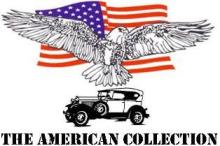
Willys MB ¼ ton truck
John Willys had a successful business selling motor cars, most particularly the Overland marque. When his supply was interrupted he purchased the Overland company and soon had the Indianapolis factory making a profit. In 1909 he bought another Indianapolis firm, the Marion Motor Car Co. and took over the defunct Pope Motor Car Co's works in Toledo, Ohio, and moved production of Overland four wheel drive vehicles to that facility in 1911. By 1915 Willys Overland was the second most important manufacturer in the States.
Willys' specialism was four-wheel drive vehicles. With the wholesale mechanisation of the military of all sides in the First World War many the United States Army realised self propelled transport was going to be an important factor in any other conflicts. Of all the American vehicle manufacturers Willys was in the best place to respond to this situation.
As the Second World War raged and threats to U.S. Interests around the world increased the United States Department of War saw the need for a light, versatile, manoeuvrable, go anywhere, reconnaissance vehicle, and came up with a very stringent set of requirements for which firms were invited to put forward their proposals. The invitations were put out on the 11th of July, 1940, with the designs to be submitted by the 22nd of July; just 11 days to digest the requirements and design a new light off road vehicle.
The US Army's most modern vehicles were at that time five 4×4 Fords purchased from Marmon-Herrington in 1937 and three Austin roadsters modified by American Bantam in 1938. Otherwise the Army was running motorcycles & sidecars and a few light vehicles (including some ageing Ford model Ts), for light reconnaissance, so it is obvious the need was urgent.
135 American Motor companies were contacted but only Willys-Overland and American Bantam were able to submit vehicles anywhere like what the War Department was looking for. The US Government pushed to include Ford in the negotiations because of the huge amount of production capacity Ford had. A further 49 days were given to the three companies to build their a prototype followed by another 75 days in which to complete 70 more test vehicles. Bantam got their vehicle into trials first and was on it's MkII version, the BRC 60, by the time it was joined in trials by the Willys Quad and Ford GP.
By the end of 1940 the US Army was clamouring for the new vehicle and under such pressure all three vehicles were signed off as acceptable, orders for 1,500 of each design were issued.
Bantam didn't really have the capacity or financial stability for a large long term contract but Willys and Ford did. Furthermore the US government had sent copies of the Bantam BRC to Willys and Ford to examine claiming the Government owned the design (which wasn't true).
After all the field tests the Willys Quad proved to be what the Army was in need of due to it's excellent power to weight ratio, all wheel drive and the incredible strong, and simple, Willys 2.2ltr, 4-cyl', 442 side-valve engine. In the end Willys, Bantam and Ford all produced the new vehicle and 'Jeep' became the most famous car to come out of WWII.



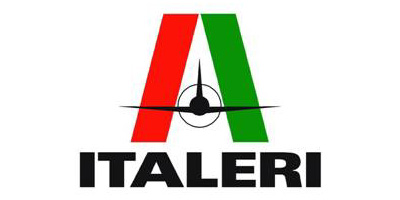
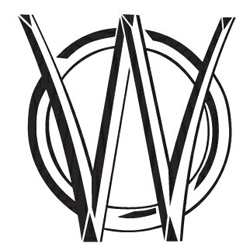



This new vehicle was officially called the U.S. Army Truck, 1/4 ton, 4x4, but buring testing was refered to as a Jeep. The term Jeep was Army mechanics slang term for any untried vehicle and had actually stuck as a name for several types of heavier equipment. The armoured branches of the US Army were also known to refer to 1/2 or 3/4 ton trucks as Jeeps, with 1/4 ton trucks being called called a "peeps". In fact there were several forms of US transportation regularly called a Jeep so the term was in popular use before the “JEEP” we know came into production.
The general purpose letters forming GP, shortened to Jeep, is a coincidence; as is the idea that the contemporary Popeye cartoon character ‘Eugene the Jeep’ (known for being able to solve all manner of problems) was an inspiration for the name.
It is most likely that the Jeep nomenclature became the well known title for this little car because of a publicity stunt by Willys-Overland who had their test driver, Irving "Red" Hausmann, drive one of the vehicles up the Capitol steps in Washington, D.C.. Having heard the troops at Camp Holabird calling the vehicle a Jeep, Hausmann gave that name as his answer when Washington Daily News reported, Katherine Hillyer, asked him what it was called. JEEP was dutifully reported in the Washington Daily News of the 20th February, 1941, with a photograph of the Jeep going up the steps. Once the name hit the news media everyone accepted it and the little go-anywhere truck became know the world over as the Jeep.

This four-wheel drive general purpose vehicle was produced from 1941 to 1945 and in time spawned a new class of vehicle that consumers would come to love. It has a wheelbase of 80in' and track of 47in' and has a folding windscreen. The engine could turn out 85lb/ft of torque and could drag a payload of 660lb with ease. These and the maximum working weight of 590kg were instigated with a view not only to cross country needs but also with an eye to use with the new paratroop infantry that could benefit from light transport that could be dropped by parachute, or glider. However the weight limit proved to be unworkable and was later increased to 980kg making the vehicle suited to glider transport, apart from a few exceptional circumstances.
Willys original design was named the MA for Military and A as it is the first letter of the Alphabet. After the three make trials the superior parts of the Bantam and Ford models, that is to say the wide flat bonnet and less weight, were incorporated into the Willys design which was now designated MB
Willys' production facilities were pushed to their limits in 1941 and they could not attain the required production of 75 Jeeps a day. Ford were given the rights to produce the Jeep too and this proved to not only meet the production numbers but also pushed design and production improvements that helped make the Jeep perform better and gave it it's iconic grille. Ford called it's Jeep production series GP, “Government – Passenger“, the W was added later to denote the vehicles Willys design. Ford found an easier way to make the Jeep front grill so the early Willys welded slat design soon gave way to the pressed steel stamping in both factories.
In total around 643,000 Jeeps were produced, 363,000 by Willys and 280,000 by Ford and Bantam. Ford also built approximately 13,000 amphibious Jeeps, nicknamed "Seep" for Sea Jeep. The GPA as it was named was inspired by the much larger DUKW but was pushed into production too quickly and suffered from lack of realistic trials. In combat these vehicles proved ungainly, slow and insufficient in size to be stable in turbulent water, although they were very handy for crossing rivers. The Russian army received a lot of these vehicles under the “Lend-Lease program” and were so useful the GAZ-46 can be attributed to the inspiration of the amphibian.





The wartime Willys MB and Ford GPW were used for a variety of roles including fire engines, field ambulances, cable layers and artillery tractors. They saw service in all theatres of war and in the Korean and Vietnam was too. In the civilian world the many lost and unwanted Jeeps found their way onto the roads of Asia most recognisable are the Filipino Jeepneys, stripped down and modified to carry as many passengers as possible and highly decorated to attract customers the Jeepneys also showed the promise of the Jeep design for things besides Military activities.
War surplus Jeeps proved to be useful to all manner of rural businesses and off road adventuring. Their colour schemes were changed of course but often straight over the original OD of the Military standards.
Today the Jeep is very popular with museums, historic societies and re-enactors. A whole industry of replacement parts and modern upgrades for the Jeep has sprung up and it is now possible to purchase an entire Jeep as individual parts and create a new vehicle for yourself (subject to road and vehicle laws etc).
The design was ground breaking and finally received appropriate recognition when the American Society of Mechanical Engineers announced the Willys-Overland Jeep MB an “International Historic Mechanical Engineering Landmark” in 1991.
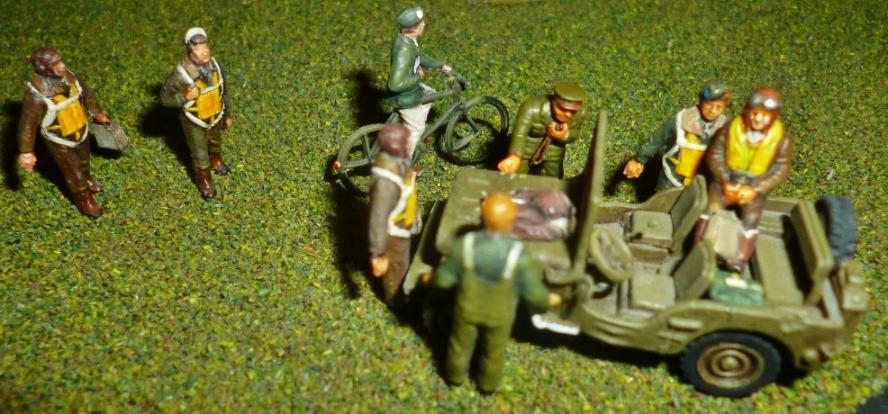


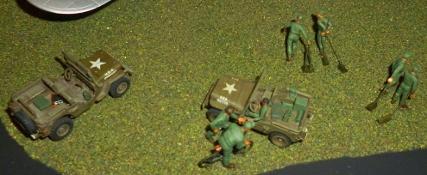



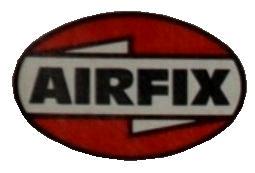






Rod's model of a 1944 Willys GP (Jeep) in it's Ex-WD colour scheme was built in October 2002 from the Italeri kit #721 in 1/24th scale. This 1970s release has resurfaced in other guises and was also released by Testors. The most recent release of this kit sees new decals for a Military Police version which compliments the previous fire and General Purpose kits. Although there are additional parts in the various versions the Jeep itself uses the same sprues.
This model is painted with Halfords acrylic car spray paints for the body and Humbrol enamels for the rest of the detail painting. Rod has clearly had a bit of fun with this kit but it is not beyond the scope of possibility as many war surplus jeeps found their way into civilian hands and in the era of peace and love.......
Ian's Military Police Jeep is from the Italeri kit, #314, re-release from the 1990s; the original tooling is from 1979. It seems that after years of putting the correct grill in the kit Italeri changed to this egg crate style grill. You don't see many of these kits built up so this is a rarity in the same manner as a stamp with the wrong water mark. In all other ways the kit is as nice as any of the Italeri Jeeps to build. This particular model is of a Polish forces Military Police vehicle from late in the war so it has had some additional exterior work, the side canvases are tissue paper over wire frames with clear acetate windows. The rest of the model is straight from the box. It is painted with Humbrol enamels and citadel acrylics.
The three OO-HO scale models on a B-17 emergency diorama were built in 2010 and are from three different kit manufacturers, highlighting how differences time and designers interpretations can produce such different results for the same item.
The earliest of the small scale Jeeps is from the Airfix LTV 4 BUFFALO & WILLYS JEEP kit product #A02302 in 1:76 scale from 2008. This is a re-release of Airfix kit #A202V which was originally labelled as OO scale. 5 other re-releases from Airfix are supplemented by MPC kit #1-6201 (1982) in 1:76 and the 1988 Tsukuda Hobby kit #876W01, also marked as 1:76. On each occasion the only difference has been the box. This is an issue because the Jeep, in particular, is very much a product of the 1960s and needs to be upgraded. Fortunately Airfix were able to release a 1/72nd scale re-boxing of Heller's 2004 kit of the Willys Jeep, kit #79997 as Airfix kit #01322, which is a better item. In 2014 Airfix released another 1/72nd scale kit as the “Airborne” Jeep set, which is a very nice rendition of the famous ¼ ton truck considered by many to be the best Jeep kit in this scale currently available.
Matchbox included their Jeep kit in several sets and Ian cannot remember which set this model actually came from. It was first built by Ian in the late 1970s and was what we now call “a glue bomb”. It was carefully striped down and rebuilt in 2010 along with the other two Jeep kits
The latest of the three kits is from the Academy WW.II Ground Vehicle Set, Academy kit# 1310, released in 1999 and re-released in 2007, This set includes an Sd.Kfz 2 Kettenkrad, a VW Kdf.1 Type 82 Kubelwagen and the Willys MB Jeep; all in 1/72 scale. this Jeep kit is the nicest of the three but isn't perfect.
All three of the jeeps have had many additional details added or enhanced for this particular diorama. They are all painted with Humbrol enamel paints brush applied.
